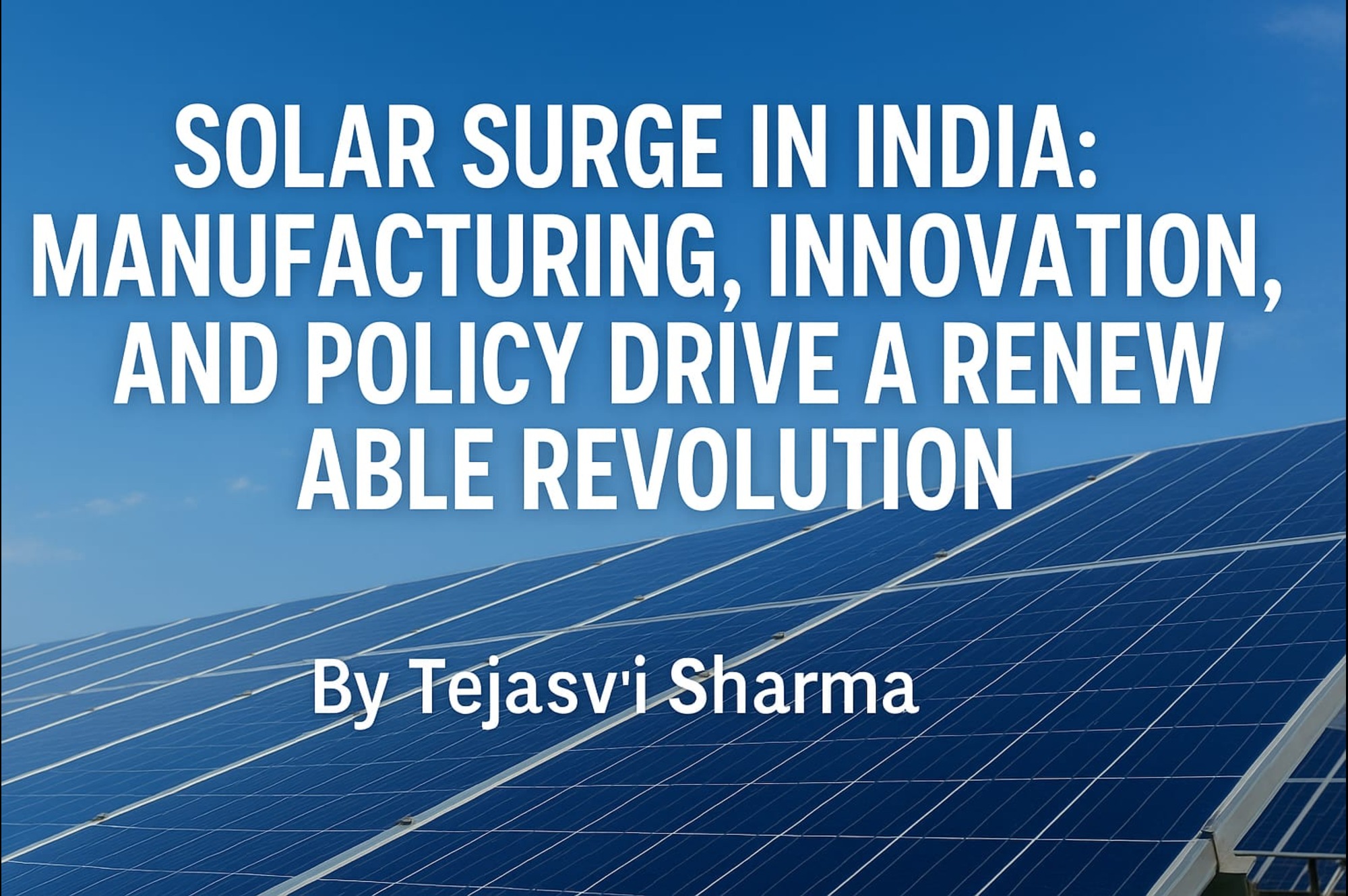Solar Surge in India: Manufacturing, Innovation, and Policy Drive a Renewable Revolution
by Tejasvi Sharma, Editor-in-Chief, EPC World
India’s solar energy sector is in the midst of a historic transformation, driven by unprecedented capacity additions, bold manufacturing targets, groundbreaking innovations, and sweeping policy reforms. In 2024, the country added 30.7 GW of new solar capacity, marking a staggering 145% year-on-year growth—catapulting India into the top league of global renewable energy leaders. This surge is not just about meeting climate commitments; it is about reshaping the nation’s energy security, creating jobs, and positioning India as a dominant force in the global clean energy supply chain.
Record-Breaking Growth in Solar Installations
The fiscal year ending March 2025 witnessed 16.9 GW of utility-scale solar installations—a 47% increase from the previous year—alongside a 72% rise in rooftop solar deployments to 5.1 GW. This rapid growth is powered by declining solar panel prices, state-specific incentives, and greater corporate adoption of solar power purchase agreements (PPAs). Cities like Ahmedabad, Hyderabad, and Jaipur are emerging as rooftop solar hotspots, driven by both commercial and residential demand for grid-connected solar systems.
Domestic Manufacturing: From Import Reliance to Export Powerhouse
India’s solar manufacturing sector is undergoing a strategic overhaul. Domestic production capacity has jumped from 6 GW (solar cells) and 37 GW (modules) in 2023 to a targeted 25 GW and 60 GW respectively by 2025. Industrial giants such as Reliance Industries, through its Dhirubhai Ambani Green Energy Giga Complex in Jamnagar, are leading the charge with plans for a 20 GW solar PV module facility. This shift is critical to reduce reliance on Chinese imports, enhance supply chain resilience, and tap into lucrative export markets across Africa, the Middle East, and Europe.
Policy Momentum and Government Schemes
The government’s PM Surya Ghar Muft Bijli Yojana, launched in February 2024 with a budget of ₹75,000 crore, is perhaps the most ambitious rooftop solar program in Indian history. It aims to provide 1 crore households with solar panels, delivering up to 300 free electricity units per month. Meanwhile, the scrapping of central renewable energy pricing pools in August 2025 has streamlined solar tariff approvals and accelerated PPA signings.
State governments are equally aggressive. Haryana has announced plans for 2.2 lakh rooftop solar systems and the solarization of over 4,500 government buildings by FY 2027. Uttar Pradesh is pursuing a 22 GW rooftop solar target and multiple utility-scale solar parks, while Telangana is attracting ₹80,000 crore in solar, wind, and floating solar investments from NTPC.
Innovation at the Forefront
The Indian solar sector is no longer just about large-scale photovoltaic plants; it is about integrating technology into every aspect of renewable energy generation. Agrivoltaics, which combines solar energy production with agriculture, is gaining traction—allowing farmers to generate income while cultivating crops under elevated solar arrays. Projects like the agrivoltaic farm at Cochin International Airport are proving the viability of this model.
Emerging technologies such as perovskite solar cells and thin-film photovoltaics promise higher efficiency, lower costs, and better performance under low-light conditions. Research institutions and private manufacturers are investing heavily in R&D to bring these technologies to commercial scale. Hybrid renewable energy systems, combining solar with wind or battery storage, are also becoming mainstream to ensure round-the-clock renewable power.
Grid Integration and Storage Challenges
While capacity growth is impressive, integration into the national grid remains a challenge. States like Kerala are already experiencing grid instability and revenue losses due to unbalanced solar injection. To address this, policymakers are exploring mandatory battery storage for rooftop systems above certain capacities, coupled with smart grid upgrades to improve load balancing.
Energy storage—particularly lithium-ion and sodium-ion battery technologies—is expected to be the next investment frontier. Several developers are now integrating battery energy storage systems (BESS) with utility-scale solar parks to stabilize supply and participate in time-of-day electricity markets.
The Road Ahead
India has set an ambitious target of 500 GW of renewable energy capacity by 2030, with solar expected to contribute over 280 GW. This trajectory will require not just capacity expansion, but also policy stability, manufacturing competitiveness, and technological innovation. The combination of government incentives, corporate ESG commitments, and global climate financing makes the outlook for the Indian solar industry brighter than ever.
The sector’s growth story is not just a tale of megawatts—it is a blueprint for energy independence, green job creation, and sustainable industrialization. If the current momentum continues, India will not only meet its domestic energy transition goals but also emerge as a global clean energy export hub, reshaping the economics of solar power worldwide.
Tags
















